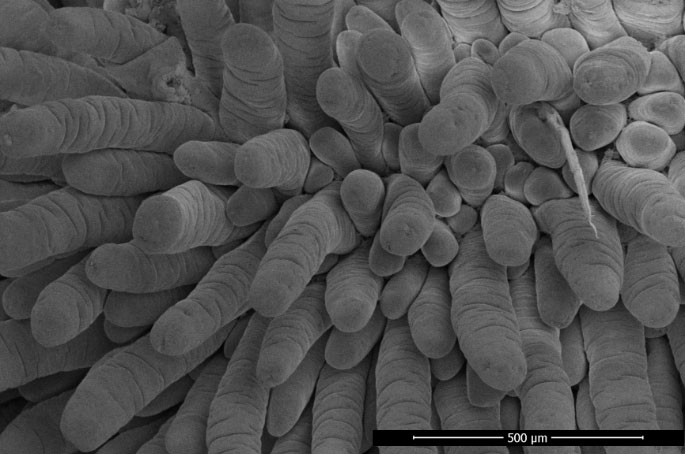Window of opportunity
The first blow is half the battle in induction of long lasting health benefits in piglets. Changes induced early in life are likely to induce lifelong changes. Improving resilience of piglets is one of the main objectives within pig husbandry. Piglets are vulnerable to a range of diseases, such as neonatal diarrhea, post weaning diarrhea, Streptococcus suis infections, during transition periods like birth and weaning, making the first weeks of life critical for piglets. Piglet resilience is influenced by the interaction between sow, piglet and their environment. During the early life period, management and environment are major influences on the development of homeostasis of the body, health, disease resistance, and production performance of piglets. This early life period creates a window of opportunity to induce changes before physiological systems become less susceptible to change. Therefore, this is the time to induce higher resilience and reduced disease susceptibility.

The power or pre- and post-natal interventions
Among many processes development of gut microbiota and the immune system determine the health of young animals. Pre- and postnatal interventions aimed at manipulating the development of microbiota and the immune system may thus induce lifelong health benefits. The exact period to introduce immunological, physiological or microbiological modifications in this critical window of opportunity is unclear. However, piglets go through two important transitions during early life, birth and weaning, that have in common that the intestinal microbiota undergoes drastic changes. Therefore, modifications during these transition periods may have large impact. Thus interventions would have to be administered before or directly after birth or weaning. These may be given either to the sow during gestation (pre-natal), during lactation, or to the piglet before or after weaning.
Pre-weaning milk replacer affects intestinal development
Providing creep feed pre-weaning can improve the intestinal development in piglets. A nutrient-dense complex milk replacer (NDM) was provided to piglets in addition to sow’s milk (de Greeff, A., 2016) and was shown to significantly increase body weight compared to piglets from the control group. Scanning electronic microscopy revealed well-developed intestinal villi in the NDM-treated group (Figure 1). Moreover, NDM-fed piglets had a significantly higher weight to length ratio of the small intestines, demonstrating that NDM induced anatomical changes in the intestine. These changes were related to increased cellular proliferation in the small intestine of NDM-fed piglets. NDM-fed piglets had significant deeper crypts and a significant different villus to crypt ratio (Table 1), indicating that NDM supplementation led to anatomical and functional changes in the gastrointestinal tract. The effect of NDM supplementation on microbial metabolites was determined in the colon. Four volatile fatty acids (VFA), mainly produced by bacteria, were found in significantly higher amounts in NDM-fed piglets suggesting changes in microbiota or microbial fermentation. This effect could be explained by the high fiber content of the NDM. Taken together, these data suggest that administration of nutrient-dense complex milk replacer led to profound changes in the intestinal development and a better performance.
Table 1. Morphometry and proliferation parameters of the small intestine of piglets fed with a nutrient-dense milk replacer – NDM (n = 15) or control piglets (n = 15). Table adapted from de Greeff et al., 2016.
| NDM | Control | |||
|---|---|---|---|---|
| Mean | St. Dev. | Mean | St. Dev. | |
| Jejunum | ||||
| Villus length | 0.618 | 0.212 | 0.541 | 0.127 |
| Crypt depth | 0.153 | 0.051 | 0.136 | 0.028 |
| Villus:crypt ratio | 4.552 | 2.231 | 4.322 | 1.422 |
| Replication1 | 0.00562a | 0.003444 | 0.003133b | 0.002143 |
| Ileum | ||||
| Villus length | 0.449 | 0.126 | 0.429 | 0.120 |
| Crypt depth | 0.174a | 0.039 | 0.132b | 0.033 |
| Villus:crypt ratio | 2.720a | 0.818 | 3.546b | 1.117 |
| Replication1 | 0.005153 | 0.002774 | 0.003773 | 0.001855 |
1 replication is determined as the percentage PCNA (proliferating cell nuclear antigen) positivity in immunohistochemistry in mm2/mm mucosa

Microbiota management to stimulate intestinal development
In the NDM study the observed changes in VFA pointed to changes in the intestinal microbiota. To demonstrate the relevance of early life microbiota manipulation, we also studied the effect of early life antibiotic treatment on intestinal development. Piglets and gestating sows were treated with either tulathromycin or amoxicillin. Subsequently microbiota development and intestinal immune development of piglets were studied as function of time. Antibiotic treatment of piglets induced changes in microbial colonization and intestinal immune development four days after treatment, as expected. However, changes were observed during at least 6 months after treatment, indicating that an early life intervention may induce long-lasting effects on intestinal health (Schokker, D., et al, 2014; 2015). Maternal antibiotic treatment also induced changes in intestinal gene expression in offspring piglets, deepened crypts in the jejunum, and decreased the number of goblet cells compared to piglets from non-treated sows. These findings demonstrate that microbiota management during gestation and lactation may induce long-lasting, even transgenerational effects in the development of the intestine and its microbiota.
Conclusion
Although microbiota research is still in its infancy and contains many pitfalls (Park, A.M., et al., 2017), its relevance and importance in improving resilience of livestock is broadly acknowledged. Our studies show that microbiota management both prenatally as well as postnatally has strong and putative long-lasting effects that may affect health and resilience of piglets.




